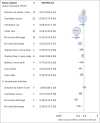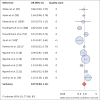Effect of water, sanitation, and hygiene on the prevention of trachoma: a systematic review and meta-analysis
- PMID: 24586120
- PMCID: PMC3934994
- DOI: 10.1371/journal.pmed.1001605
Effect of water, sanitation, and hygiene on the prevention of trachoma: a systematic review and meta-analysis
Abstract
Background: Trachoma is the world's leading cause of infectious blindness. The World Health Organization (WHO) has endorsed the SAFE strategy in order to eliminate blindness due to trachoma by 2020 through "surgery," "antibiotics," "facial cleanliness," and "environmental improvement." While the S and A components have been widely implemented, evidence and specific targets are lacking for the F and E components, of which water, sanitation, and hygiene (WASH) are critical elements. Data on the impact of WASH on trachoma are needed to support policy and program recommendations. Our objective was to systematically review the literature and conduct meta-analyses where possible to report the effects of WASH conditions on trachoma and identify research gaps.
Methods and findings: We systematically searched PubMed, Embase, ISI Web of Knowledge, MedCarib, Lilacs, REPIDISCA, DESASTRES, and African Index Medicus databases through October 27, 2013 with no restrictions on language or year of publication. Studies were eligible for inclusion if they reported a measure of the effect of WASH on trachoma, either active disease indicated by observed signs of trachomatous inflammation or Chlamydia trachomatis infection diagnosed using PCR. We identified 86 studies that reported a measure of the effect of WASH on trachoma. To evaluate study quality, we developed a set of criteria derived from the GRADE methodology. Publication bias was assessed using funnel plots. If three or more studies reported measures of effect for a comparable WASH exposure and trachoma outcome, we conducted a random-effects meta-analysis. We conducted 15 meta-analyses for specific exposure-outcome pairs. Access to sanitation was associated with lower trachoma as measured by the presence of trachomatous inflammation-follicular or trachomatous inflammation-intense (TF/TI) (odds ratio [OR] 0.85, 95% CI 0.75-0.95) and C. trachomatis infection (OR 0.67, 95% CI 0.55-0.78). Having a clean face was significantly associated with reduced odds of TF/TI (OR 0.42, 95% CI 0.32-0.52), as were facial cleanliness indicators lack of ocular discharge (OR 0.42, 95% CI 0.23-0.61) and lack of nasal discharge (OR 0.62, 95% CI 0.52-0.72). Facial cleanliness indicators were also associated with reduced odds of C. trachomatis infection: lack of ocular discharge (OR 0.40, 95% CI 0.31-0.49) and lack of nasal discharge (OR 0.56, 95% CI 0.37-0.76). Other hygiene factors found to be significantly associated with reduced TF/TI included face washing at least once daily (OR 0.76, 95% CI 0.57-0.96), face washing at least twice daily (OR 0.85, 95% CI 0.80-0.90), soap use (OR 0.76, 95% CI 0.59-0.93), towel use (OR 0.65, 95% CI 0.53-0.78), and daily bathing practices (OR 0.76, 95% CI 0.53-0.99). Living within 1 km of a water source was not found to be significantly associated with TF/TI or C. trachomatis infection, and the use of sanitation facilities was not found to be significantly associated with TF/TI.
Conclusions: We found strong evidence to support F and E components of the SAFE strategy. Though limitations included moderate to high heterogenity, low study quality, and the lack of standard definitions, these findings support the importance of WASH in trachoma elimination strategies and the need for the development of standardized approaches to measuring WASH in trachoma control programs.
Conflict of interest statement
Children Without Worms receives funding from Johnson & Johnson and GlaxoSmithKline for its programs to control soil-transmitted helminthiasis.
Figures


















Similar articles
-
Water, sanitation, hygiene, and soil-transmitted helminth infection: a systematic review and meta-analysis.PLoS Med. 2014 Mar 25;11(3):e1001620. doi: 10.1371/journal.pmed.1001620. eCollection 2014 Mar. PLoS Med. 2014. PMID: 24667810 Free PMC article.
-
Antibiotics for trachoma.Cochrane Database Syst Rev. 2011 Mar 16;(3):CD001860. doi: 10.1002/14651858.CD001860.pub3. Cochrane Database Syst Rev. 2011. Update in: Cochrane Database Syst Rev. 2019 Sep 26;9:CD001860. doi: 10.1002/14651858.CD001860.pub4. PMID: 21412875 Updated.
-
Face washing promotion for preventing active trachoma.Cochrane Database Syst Rev. 2015 Feb 20;2015(2):CD003659. doi: 10.1002/14651858.CD003659.pub4. Cochrane Database Syst Rev. 2015. PMID: 25697765 Free PMC article.
-
Signs and symptoms to determine if a patient presenting in primary care or hospital outpatient settings has COVID-19.Cochrane Database Syst Rev. 2022 May 20;5(5):CD013665. doi: 10.1002/14651858.CD013665.pub3. Cochrane Database Syst Rev. 2022. PMID: 35593186 Free PMC article.
-
Interventions to improve water, sanitation, and hygiene for preventing soil-transmitted helminth infection.Cochrane Database Syst Rev. 2022 Jun 21;6(6):CD012199. doi: 10.1002/14651858.CD012199.pub2. Cochrane Database Syst Rev. 2022. PMID: 35726112 Free PMC article.
Cited by
-
Trachoma Prevention Practice and Associated Factors in Rural Lemo District, Southern Ethiopia, 2021.Ethiop J Health Sci. 2023 Jan;33(1):123-132. doi: 10.4314/ejhs.v33i1.16. Ethiop J Health Sci. 2023. PMID: 36890944 Free PMC article.
-
Household Survey of Trachoma among Children Living in Pernambuco, Brazil.Pathogens. 2019 Nov 25;8(4):263. doi: 10.3390/pathogens8040263. Pathogens. 2019. PMID: 31775360 Free PMC article.
-
Killing of diverse eye pathogens (Acanthamoeba spp., Fusarium solani, and Chlamydia trachomatis) with alcohols.PLoS Negl Trop Dis. 2017 Feb 9;11(2):e0005382. doi: 10.1371/journal.pntd.0005382. eCollection 2017 Feb. PLoS Negl Trop Dis. 2017. PMID: 28182670 Free PMC article.
-
WASH Upgrades for Health in Amhara (WUHA): study protocol for a cluster-randomised trial in Ethiopia.BMJ Open. 2021 Feb 22;11(2):e039529. doi: 10.1136/bmjopen-2020-039529. BMJ Open. 2021. PMID: 33619183 Free PMC article.
-
Fine scale mapping of water sources in low-income settings: A comparative study in Misungwi, Tanzania.PLoS One. 2025 Mar 21;20(3):e0319603. doi: 10.1371/journal.pone.0319603. eCollection 2025. PLoS One. 2025. PMID: 40117245 Free PMC article.
References
-
- Pascolini D, Mariotti SP (2012) Global estimates of visual impairment: 2010. Br J Ophthalmol 96: 614–618. - PubMed
-
- WHO (2013) Weekly Epidemiological Record. 24: 241–256.
-
- Murray CJ, Vos T, Lozano R, Naghavi M, Flaxman AD, et al. (2013) Disability-adjusted life years (DALYs) for 291 diseases and injuries in 21 regions, 1990–2010: a systematic analysis for the Global Burden of Disease Study 2010. Lancet 380: 2197–2223. - PubMed
Publication types
MeSH terms
Substances
LinkOut - more resources
Full Text Sources
Other Literature Sources
Miscellaneous

